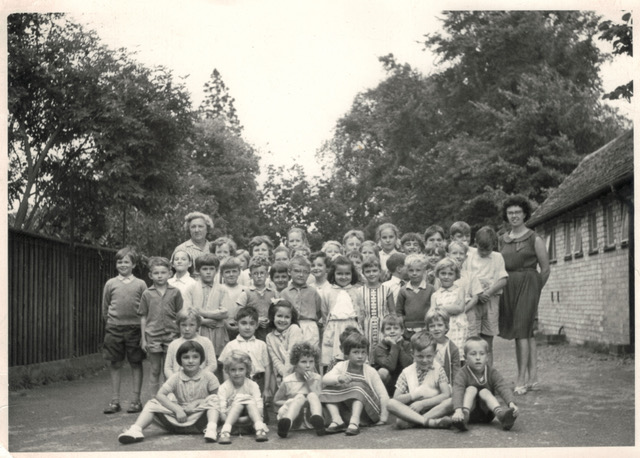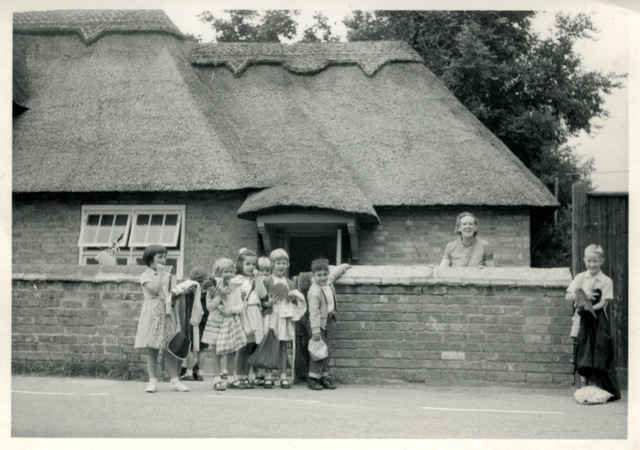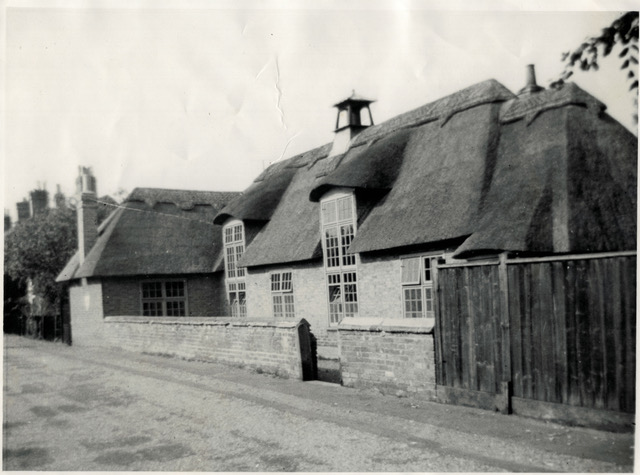Its reputation for high academic standards and success in the ‘Eleven-plus’ examination, together with its friendly
atmosphere and smaller numbers of pupils made it a popular choice for Village parents, and at times it even drew
children from as far away as St Ives and beyond.
The fact that it was a Church school added an extra dimension to the
children’s education: prayers and hymns were an essential part of the daily routine. Children were introduced to the
Church’s liturgy in a way that was sympathetic and mature. There was no ‘dumbing down’ of religion; instead, the traditional
language of the Church was used and explained, so that the children learned and understood the catechism, hymns, prayers, and
Bible passages that would accompany them for life.
There was a close and fruitful relationship with St Margaret’s Church,
and the various rectors would pay regular visits to the School for Scripture lessons and special assemblies.
Similarly, the children would all attend St Margaret’s, above all at Christmas, where they would play a special part
in the yearly Carol Service.
Sadly, by 1978, the School roll had dwindled to around 24, and the Local Education Authority, which exercised
‘voluntary control’ over the School, and, of course, funded it, decided that the numbers of children could no longer
sustain a school in the Village. Thus, it was closed, and the children were transferred to the County Primary School in
Hemingford Grey.
Perhaps one day, a detailed history of the School will be written: materials in the form of old log books and photographs
are still available. In the meantime, I should like to set down some of the history of the School in this short article.
I should begin by pointing out that I am one of the few remaining ex-pupils of the School who still live in the Village.

The photograph, taken in the playground in about 1960, shows a thriving school of over forty pupils.
I am the boy standing on the far left. I can still recognize some of the others, some of whom still live in the Hemingfords.
Perhaps those who recognize themselves or other people will get in touch. The two teachers were my grandmother,
Mrs Blanche Cornell (back left), the Headmistress from 1947 to 1968, who taught Juniors (eight to eleven-year olds)
and my mother (back right), Mrs Penelope Yeandle, who taught Infants (five to seven-year olds) from 1960 to 1978.
It is, of course, unusual to be taught at school by family members, but the whole School was like one big family,
and the children were all treated with the care and concern appropriate to a family. Discipline came naturally,
and punishment was hardly ever necessary.
The School was founded in 1867 (the year in which Queen Victoria laid the foundation stone of the Royal Albert Hall),
when the Rector, the Revd Henry Herbert (1824-1911), in whose memory the East Window in St Margaret’s church was dedicated,
gave the land for the building.
Henry Herbert was the great grandfather of the present Lord Hemingford, whose son,
Christopher Herbert, was one of the youngest pupils on the School roll, when it closed in July 1978.
If it had not closed, in 2018 we should have celebrated its 150th anniversary and coincidentally the 70th anniversary of
Mrs Cornell’s assumption of the headship.
In the early days, prior to the Second World War, the pupils reflected the mainly
agricultural nature of the Village. The first entry in the Log Book for 1914 onwards explains how the School was reopened
on 7 September 1914 after the ‘harvest holiday’ of five weeks. Poor attendance is a recurring theme: out of 58 on the books,
only 42 were present on the first day of term.
In the days when people rarely travelled beyond their immediate neighbourhood, agriculture, Church holy days, the seasons,
and secular holidays were part of the School’s cycle. On 5 October 1914, it is noted that several children were away with
their parents at St Ives market. On 13 October, the children were given a half-day’s holiday to visit St Ives fair.
The fair caused attendance to dip to 79% for the week.
Frequent visits by the Rector, the Revd Francis Falkner Herbert, son of Henry Herbert, to give Scripture lessons, were recorded.
On Ash Wednesday (19 Feb 1915), the children went to church in the morning and had a half-day’s holiday in the afternoon.
Similarly, even as late as 1958, Ascension Day was marked by a service in church, followed by a holiday.
Rain, snow, storms, and cold disrupted the smooth running of the School. Mrs Cornell writes, in the winter of 1963, that,
despite ‘good fires in the stoves’, it was impossible to raise the temperature above 46 °F (7.8 °C). The children took it in
turns to sit near the coal fires in the single cast-iron stoves at the front of the rooms and undertook much PE to keep warm.
Physical exercise, albeit of a not too strenuous nature, was encouraged, and the School held its own annual Sports Day on the
Village playing field. Egg and spoon races, sack races, and many others provided an opportunity for pupils and parents alike
to share in the friendly competition, and the pupils were afterwards rewarded with a crate of ginger ale, the kind gift of the
Chairman of the Managers (governors), Mr Frank Rooke.
Netball was eagerly played in the small playground, which housed the
specially built outside lavatories, in which the water froze in winter. Summer saw rounders on the playing field and country
dancing on the lawns of several houses in the Village, for example at Whiteways and Barn Hall.
The Rectory lawn
(now the house of Mr and Mrs Roger Dearlove) provided an adjunct to the playground, and Mr and Mrs Stevens, the Rector and his wife,
welcomed the pupils to dance around the maypole to special records, played on the newly acquired electric gramophone.
I believe we were the first school in the County to own and regularly use its own maypole.

Pupils in the 1960s
However, nowhere was the community
spirit of the School more apparent than at the annual pre-Christmas carol concert and party. Mrs Cornell ensured that the School was
decorated literally to the rafters, with streamers, lanterns, baubles and all manner of things adorning the whole School, which was
turned into one huge room, by folding back the wooden partition between the two classrooms. Parents and other Villagers were
invited as well as all the children; the Rector would dress up as Father Christmas; presents would be handed out by the
Dowager Lady Hemingford; and all would eat their fill of sandwiches, sausage rolls, trifle, jelly, etc. The mirth was endless.
It can, I think, be appreciated that the School was quite exceptional, if not unique, at least in the 1960s, when I knew it.
Not only did it prepare pupils academically and spiritually, but it also gave great joy to the pupils and the whole Village.
We learned by doing and experiencing, not just out of books. Pupils passing through the Village to the Common or Meadow for a nature
walk were a frequent sight. Art and music were greatly encouraged – we learned to sing besides hymns a wide variety of folksongs
and practised many crafts besides painting. All of this was accomplished by two teachers in mixed-age classes, with a minimum of
support in the early days, not even a telephone.
Nourishing school meals were shipped in from Fenstanton and served from the
rudimentary kitchen by the kindly Mrs Molly Nickson. The School was kept clean and heated by the longsuffering Mrs Stepney,
who would arrive, often before dawn, to stoke the stoves, and would return in the evening to clean and lock up. As time progressed,
a part-time Assistant Teacher, Mrs Maisie Jones, and a School Secretary, Mrs Joyce Orr, added to the happy little community.
The building still stands, now converted into a dwelling; the playground has become a garden; the lavatories have been
demolished. However impractical the building was for modern educational needs, one is bound to look back nostalgically on an
institution that gave so much to the Village and contributed enormously to its unique spirit.

Mrs Nickson keeps a watchful eye on pupils leaving School.
[David Yeandle was a pupil at Hemingford Abbots School from 1960 to 1964. If you wish to contact him about this article, please send an
email to david@yeandle.co.uk.]



